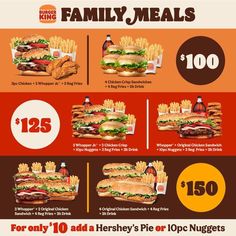Analyzing The Burger King Menu: A Comprehensive Breakdown

Burger King, one of the world's most iconic fast-food chains, has long been renowned for its signature Whopper sandwich and a diverse menu that caters to a wide range of customer preferences. As a leader in the industry, Burger King's menu offerings play a crucial role in its success and ability to remain competitive in the ever-evolving fast-food landscape.
In this comprehensive analysis, we'll delve into the intricacies of the Burger King menu, exploring its key components, nutritional information, and the strategic considerations behind the company's menu engineering.
The Burger King Menu: An Overview
The Burger King menu is a testament to the brand's commitment to providing a diverse range of options to its customers. From the classic Whopper to innovative limited-time offerings, the menu is designed to appeal to a broad spectrum of tastes and dietary preferences.

Burgers
At the heart of the Burger King menu are its signature burger offerings. The Whopper, the brand's flagship product, is a flame-grilled beef patty topped with a variety of classic toppings, including tomatoes, onions, pickles, and the brand's signature mayonnaise-based sauce. In addition to the Whopper, Burger King offers a range of other burger variations, such as the Bacon King, the Big King, and the Impossible Whopper, catering to different flavor preferences and dietary needs.
Chicken and Fish
Recognizing the growing demand for non-beef options, Burger King has expanded its menu to include a variety of chicken and fish-based offerings. These include the Original Chicken Sandwich, the Spicy Crispy Chicken Sandwich, and the BK Fish Sandwich, providing customers with alternative protein sources.
Sides and Beverages
Complementing its burger and sandwich offerings, Burger King's menu also features a selection of sides and beverages. The classic French fries, onion rings, and chicken nuggets are staples, while the brand's beverage lineup includes soft drinks, milkshakes, and coffee-based drinks.
Breakfast Menu
Burger King's breakfast menu caters to the early risers, offering a range of morning-friendly items such as the Croissan'wich, the Breakfast Burrito, and the French Toast Sticks, allowing customers to start their day with a Burger King meal.
Nutritional Considerations
As consumers become increasingly health-conscious, Burger King has made efforts to provide nutritional information and offer menu items that cater to various dietary needs.
The Burger King menu features a range of calorie, fat, and sodium content across its offerings. For example, a classic Whopper contains 660 calories, 40 grams of fat, and 1,170 milligrams of sodium, while the Impossible Whopper, a plant-based alternative, contains 630 calories, 34 grams of fat, and 1,020 milligrams of sodium.
To accommodate customers with specific dietary requirements, Burger King also offers vegetarian and vegan options, such as the Impossible Whopper, as well as low-calorie and low-carb alternatives, like the Grilled Chicken Sandwich and the Garden Salad.
Strategic Considerations in Menu Engineering
Burger King's menu is the result of a carefully crafted strategy that aims to balance customer preferences, operational efficiency, and profitability.
Responding to Trends and Evolving Preferences
Burger King closely monitors industry trends and consumer preferences to ensure its menu remains relevant and appealing. The introduction of the Impossible Whopper, a plant-based burger, is a prime example of the brand's responsiveness to the growing demand for meatless options
Maintaining a Balanced Menu
Burger King's menu is designed to offer a balance of classic favorites, innovative offerings, and healthy alternatives. This approach allows the brand to cater to a diverse customer base, from traditional fast-food enthusiasts to health-conscious consumers.
Optimizing Operational Efficiency
The Burger King menu is also engineered with operational efficiency in mind. By offering a streamlined menu with core items and limited-time offerings, the brand can optimize its supply chain, reduce waste, and ensure consistent quality across its vast network of restaurants.
Driving Profitability
Ultimately, Burger King's menu strategy is aimed at driving profitability. By offering a mix of high-margin items, value-based offerings, and limited-time promotions, the brand can maximize revenue and maintain a competitive edge in the fast-food industry.
Conclusion
The Burger King menu is a testament to the brand's commitment to providing a diverse range of options that cater to the evolving preferences and dietary needs of its customers. Through strategic menu engineering, Burger King has positioned itself as a leader in the fast-food industry, offering a balanced and innovative selection of burgers, chicken, and other menu items that continue to captivate and satisfy its loyal customer base.
Sign up for FD's newsletter
The freshest stories from the food and dating world every week.




